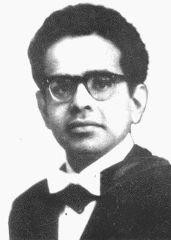Indian researchers say they lost a great opportunity for recognition of their work on in-vitro fertilization (IVF) technique for which Robert Edwards of Britain got the 2010 Nobel Prize in Medicine.
"Bureaucratic arrogance and vindictiveness by our own colleagues in the medical fraternity spoiled our case" says Sunit Mukherjee, the only surviving member of an Indian team led by Subhas Mukherjee that created Durga — India's first test tube baby in a Kolkata hospital — 67 days after the birth of Marie Louise Brown on July 25, 1978 in London.
Subhas Mukherjee 
The birth of Durga was not documented in a research journal apparently because Subhas Mukherjee had not taken approval for his embryo experiments from any ethics committee. However, after analyzing Subhas's handwritten laboratory notes, scientific papers and technical reports submitted to the West Bengal government, T.C. Anandkumar — a former director of the Institute for Research in Reproduction in Mumbai and creator of India's first scientifically documented test-tube baby in Mumbai on August 6, 1986 — said it was "a brilliant achievement under trying conditions."
According to Anandkumar, the small report that Subhas Mukherjee sent to the government in 1978 clearly showed that "he was on the right line of thinking much before anyone else had demonstrated successful outcome of a pregnancy following the transfer of an 8-cell frozen-thawed embryo into human subjects." Subhas, he said, became a victim of "Indian Crab Syndrome" which results in "none of the crabs kept in a basket ever reaching the top because the remaining crabs pull it down." Much of Subhas's work remained unpublished not because he did not have data but because he was not given a chance to do so by his administrative ministry in the government, Anandkumar said in an earlier report.
"We lost our claim to be the first in the world in not only fertilizing human eggs in vitro but also cryo-preserving the embryo, thawing it and in the birth of a healthy normal baby following embryo replacement in the mother's womb" Anandkumar said.
Sunit Mukherjee said Subhas was the first to use human menopausal gonadotrophins (hMG) to produce extra eggs, employ the transvaginal route to extract the eggs under ultra sonographic guidance and successfully freezing and thawing human embryos using a reagent called DMSO. "These are the methods now followed in IVF clinics world over," said Sunit Mukherjee. "Edwards did not freeze the embryo, and his laparoscope technique of extracting eggs from ovaries was more difficult," he said.
